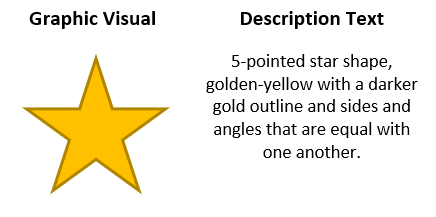
We have spent a lot of time recently discussing why your graphic design choices are crucial to your business and how you can improve your design to benefit your company and your audience.
And we’re not done! Today, we’re laying out four critical facts about graphic design to help further emphasize its importance in your marketing.
Graphic Design Fact #1: More Than 90% of Info Transmitted to the Brain Is Visual
Of the five senses—sight, sound, smell, taste, and touch—sight is the one we rely on heaviest to navigate the world. The brain interprets and responds to what we see much faster and more accurately than to what we hear, smell, taste, or feel. And while all five senses are essential and work together for our benefit, it’s our sight that is most dominant in processing and decision-making:
- If you smell smoke, you look around to see where it’s coming from to determine your next action.
- If you hear a rattlesnake, you look around to see where it is in proximity to you to determine where your next step should fall.
- If you feel a tap on your shoulder, you look to see who it is to determine how to respond.
While other senses can alert you to a problem or situation first, it’s your sense of sight that takes over to best assess the circumstances of the moment and guide your responses, and that is because the brain processes visual cues much faster and more precisely than other stimuli.
What Does This Fact Mean for Your Business?
Since 90% of the information received by the brain is visual, you should use this to your advantage by maximizing the visual aspects of your marketing:
- Apply high-quality visuals and graphics wherever possible to communicate quickly and effectively with your audience.
- Incorporate engaging images on your website, blog articles, social media, print pieces, and everywhere else you market yourself or communicate with audiences.
- Evaluate your logo and brand colors and make any necessary adjustments if they don’t accurately reflect your brand.
The marketing materials your business produces are what your audience is going to see and interpret, so it is important to implement strong visual content wherever possible.
Graphic Design Fact #2: The Brain Processes Images 60,000 Times Faster than Text Alone
They say an image is worth a thousand words, and the brain can process the “words” of an image far faster than it can a written-out description of the image.
Take the following, for example:

The brain processes visual cues so quickly that it takes about 0.25 seconds to look at something and understand the essentials. Just glancing at the star figure provides the basic facts—star-shaped, golden-yellow, darker gold outline, as tall as it is wide, etc. Reading the description on the right forces you to piece together each listed quality to form an image of the star in your mind, roughly a 5-10 second endeavor. While the description of the star figure paints an okay picture of it textually, it is much easier and faster to simply look at the graphic visual of the star figure. Plus, the description can only do so much in explaining the colors, size, and angles. It’s more accurate to see it than read about it.
What Does This Fact Mean for Your Business?
Because the brain processes visuals 60,000 times faster than blocks of text, and because users have an average of 8-second attention spans when in online spaces now, it is crucial for you to utilize compelling visuals that capture audiences’ attention and communicate with them as quickly and efficiently as possible.
Graphic Design Fact #3: People Retain What They See Better Than What They Read or Hear
Within three days of reading or hearing something, without a visual accompanying the information received, the brain only retains about 15% of what it has seen. With a visual—whether an infographic, diagram, or picture— you are likely to remember up to 65% of the information presented after the same period. (source)
Short-term and long-term memories are primarily visual. Sounds and smells can trigger a memory, but the mental images or snippets of a moment are what you rely on most to recall a memory. When you give someone information attached to a visual they can hold onto in their memory bank, there is a higher chance your audience will be able to recall the information you wanted them to receive.
What Does This Fact Mean for Your Business?
Since the brain processes and stores information from a visual much better than spoken or written information, you can strengthen your marketing by creating helpful infographics, diagrams, and other visual pieces that capture your audience’s attention and help them remember the key informational points.
Graphic Design Fact #4: The Better Your Present Yourself, the More Engaged Your Audience Will Be
People care about how you present yourself, from your web design to your digital ads, social media posts, print pieces, and logo. Quality and cohesion matter because they tell your audience you care about their experience and how you come across them.
When it comes to your website, graphic design plays a massive role in your site’s UX. Take a look at these not-so-surprising stats regarding web design and UX:
- It takes 0.5 seconds for a visitor to form a first impression of a site.
- 94% of the first impression is based on the design.
- Visitors spend about 6 seconds studying the main image on your site.
- Sites with low-quality designs will quickly lose about 38% of visitors.
- 88% of visitors will avoid a site after a bad user experience.
- 57% of site visitors will not recommend a company with a poor mobile design.
And while these stats apply to websites, specifically, they can also translate to other areas that rely on design, such as print pieces, digital ads, and social media pages. If any component of your marketing plan disregards the quality of the design, you are not going to capture your audience effectively or engage with them very well.
What Does This Fact Mean for Your Business?
Your design choices tell your audience one of two things: you either care or you don’t. High-quality graphics and design choices that are informative, helpful, and engaging say to your audience, “We put in the effort to communicate with you because we care about your experience and we care about our business.” On the other hand, low-quality designs tend to tell everyone, “We don’t care about your experience with us enough to create something you would want to engage with, and we don’t put in the effort to provide you with the right message.”
When you present yourself well to your audience, they are far more likely to choose your business over the less-caring or less convincing competition.
Our Graphic Designers Are Ready to Boost Your Business Through Effective Marketing! Call Us at 478-621-4491
If you would like to help strengthen your communication with your audience through high-quality graphic design, talk to our team today. Our in-house designers are available to speak with you about your business and create the visuals that best represent you. Contact one of our friendly account managers today with your questions.
Did you love this article? Make sure you sign up for our monthly eNewsletter, so you never miss one.
We love good design, and we’re sharing that love this summer. From now through September, we’ll share tips, information, and best practices for using high-quality graphic design to build and promote your business.
Other posts in this series:
- 4 Ways Your Design Choices Can Help or Hurt Brand Perception
- Want to Spread Your Message? Don’t Ignore Your Message Design
- How Branding and Graphic Design Has Served Abbeville Commissioning in South Georgia
- How To Enhance Your Digital Ads with High-Quality Visuals
- What Do Your Brand Fonts Say to Your Audience?

